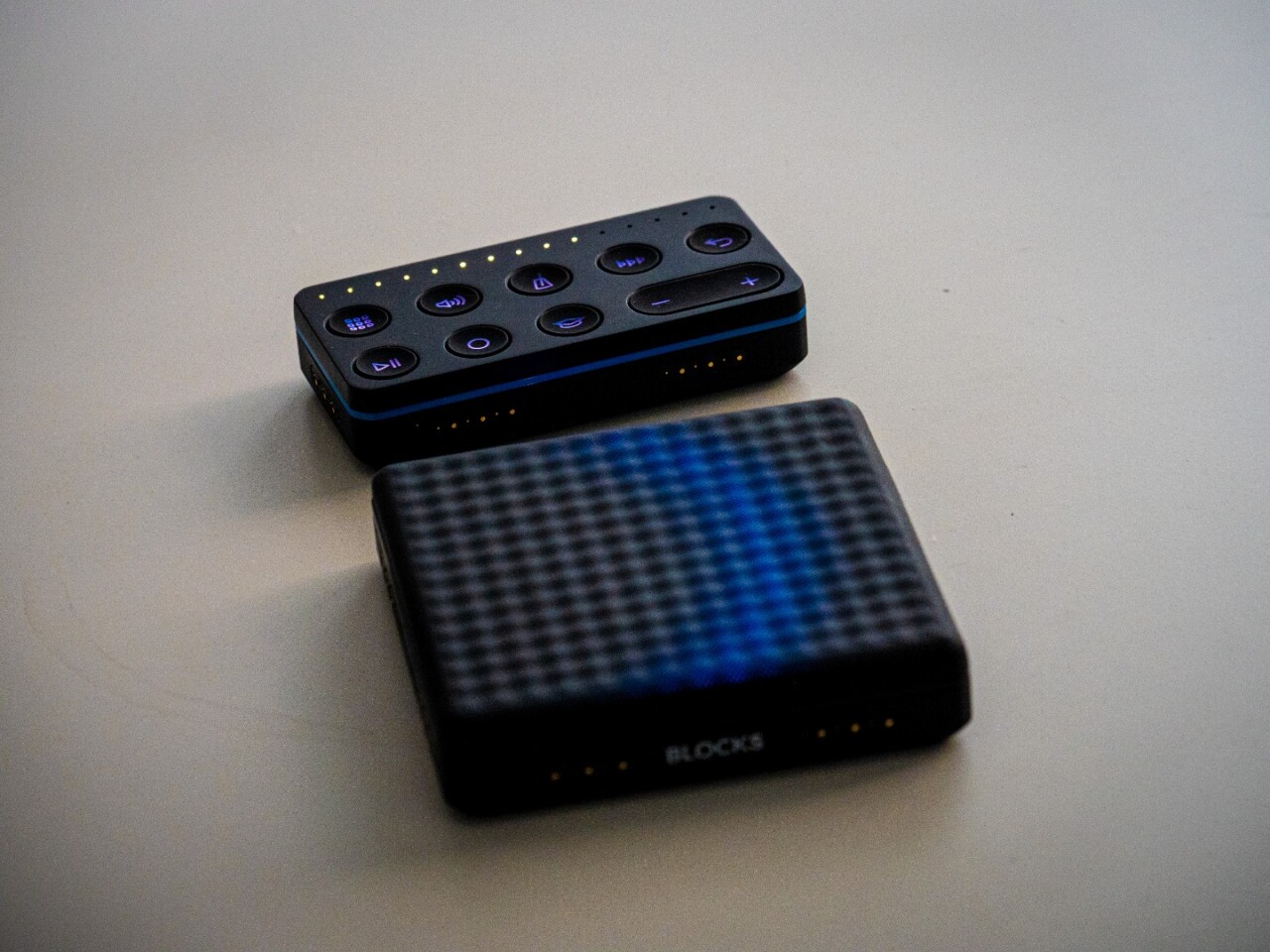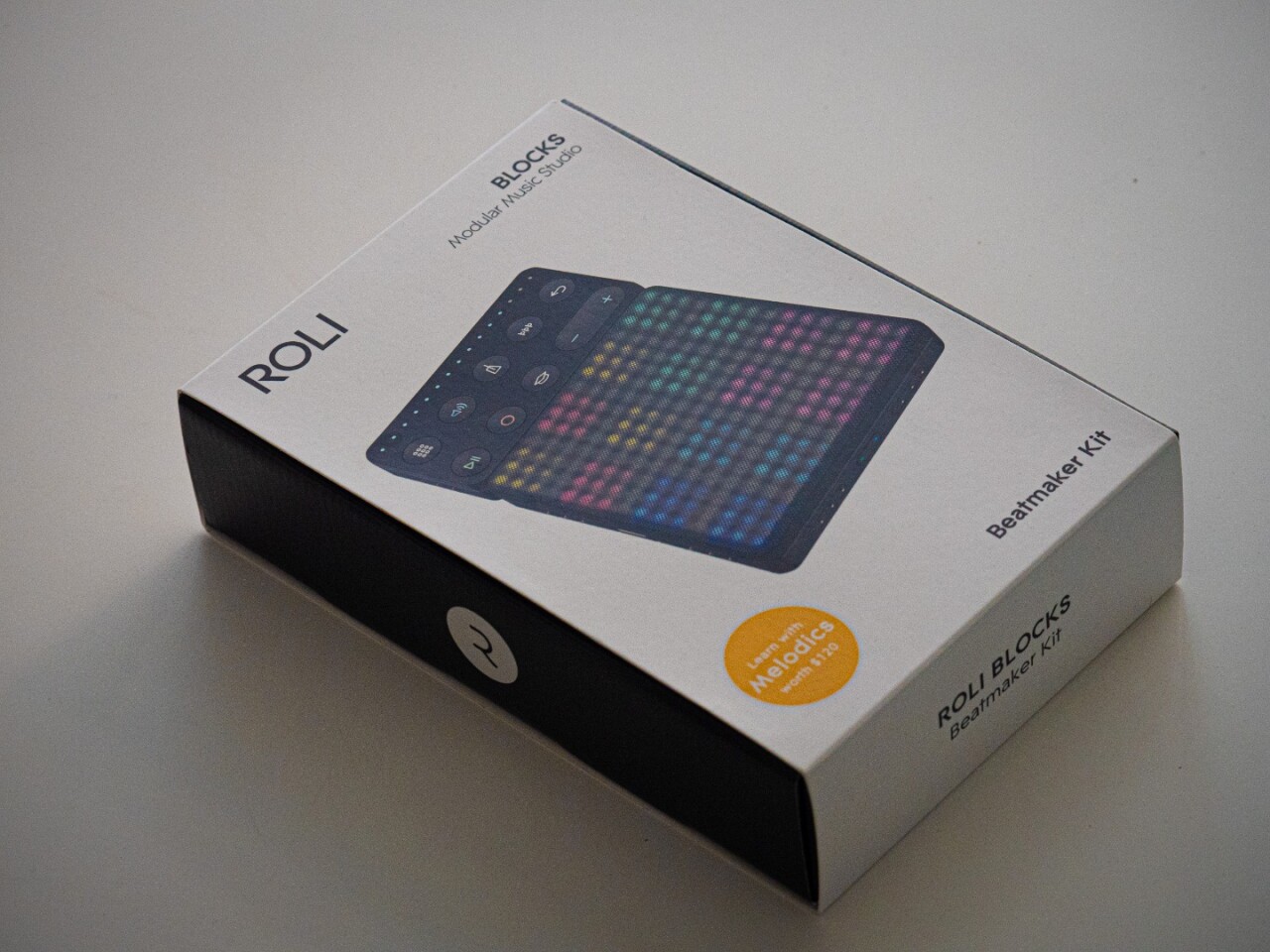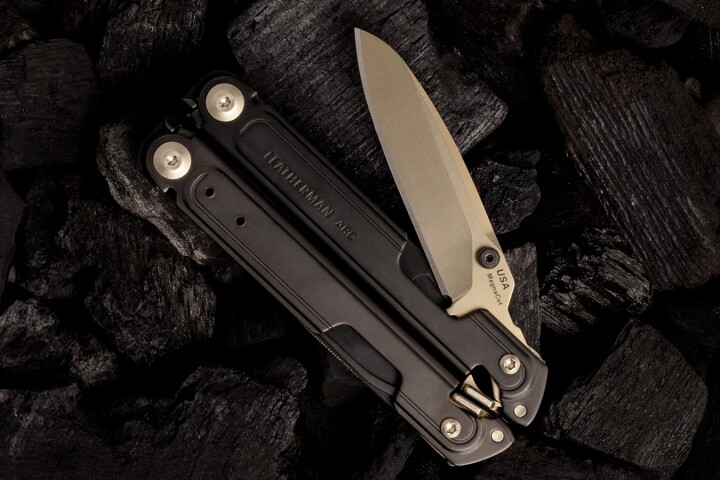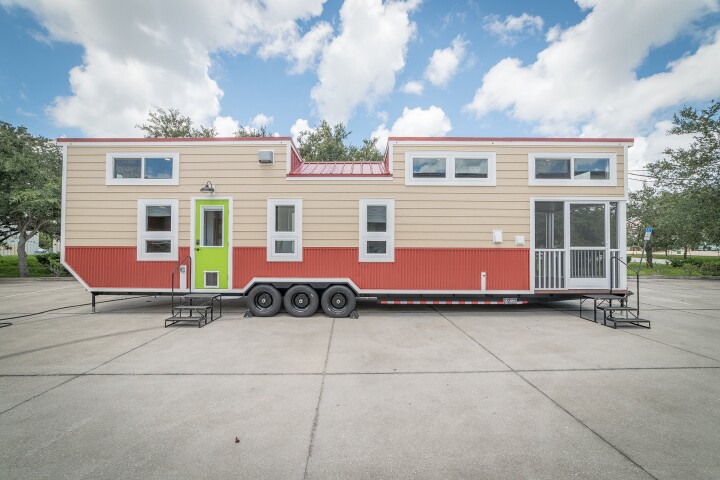Roli is in the business of making weird, creatively-designed and hyper-expressive MIDI instrument controllers. Its Beatmaker Kit features the Lightblock, a beautiful, portable, wireless digital controller that's so flexible to play that, with the right instrument, it almost feels organic and analog. Here's our review.
The Roli Beatmaker kit comes with two jiggers. One is the Roli Lightblock, the other is the control block, and they snap together magnetically to operate as a single unit, or combine with other Lightblocks or Roli Seabord keyboards to give you a modular and expandable kit.
What do they do? Well, effectively, they're MIDI controllers for music production so the answer is, they can do just about anything depending on what they're running through. But the Lightblock – much like Roli's own Seabord – is much more flexible and expressive than your typical MIDI keyboard.
For starters, it's pocket-sized and wireless, connecting to your PC or mobile device either via Bluetooth or a simple USB-C cable if you want to go wired. That makes it a quick and fun device to take with you for playing around with music production on the go. The battery lasts four hours, and the Bluetooth range is about 15 m (50 ft).
Then, there's the Lightblock's expressive capabilities. Its soft silicon surface allows you not only to strike notes, but to bend and warp them as you hold them. To bend pitch, you slide your finger left or right after you hit the note, much like you would on a cello, also providing the ability to make a nice natural, manual vibrato effect. You can also slide up and down, which can give you access to a range of expressive filters. And, of course, there's aftertouch pressure modulation, meaning you can vary the volume and timbre of a note depending on how hard you press.
It's also quite a visual machine, with a bunch of full-color LEDs under the silicone surface that can light up to transform the Lightblock into all sorts of different surfaces depending on how you're using it. You can make it a 2x2 grid or a 4x4 grid and use it as a simple drum pad. You can go to a 5x5 grid that gives you a chromatic scale – and you can nominate what scale you're playing in and have only the notes in that scale light up, making it easy to stay in key. Or you can simply use it as an effects controller, using one hand on a separate keyboard and another on the Lightblock to control expressive filters on the sound.
Realistically, if you know your way around a DAW (digital audio workstation) like Ableton Live or any of a hundred others, you can get into the guts of them and map the Lightblock's hyper-flexible capabilities to do pretty much whatever the hell you want.
I, however, do not know my way around a DAW. I'm a lapsed musician with a decade's experience behind a drum kit and two more as a singer. I can comfortably noodle on a piano or guitar, but it's been many years since I hit the studio for recording or rolled the sleeves up on Protools or Logic. I am, in other words, a numpty. And since Roli is pitching the Beatmaker kit in such a way as to welcome numpties as much as more seasoned producers, my thoughts may be instructive.

As a drum pad
To get myself started, I jumped into the free six-month Melodics subscription that comes with the Beatmaker Kit. Melodics is an educational course designed to help you get your finger-drumming chops together with a series of exercises that slowly ratchet upward in difficulty.
Most of these exercises, at least as far as I got, gave me a 4x4 grid to work with and a Guitar Hero-style series of notes flying at you that you've got to hit accurately and on time. I found the latter part was easier on a cable connection than over Bluetooth because, although the wireless connection was sometimes pretty snappy, at other times there was some latency, and there didn't seem to be a whole lot of rhyme or reason as to why.
The exercises themselves weren't bad fun, and once I worked my way up a couple levels, I had some pretty funky beats going against the nicely-produced backing tracks. I wouldn't consider it a perfect drum controller – the small size and lack of physical delineations between notes made me miss a fair bit (that's my excuse, and I'm sticking to it), and the Lightblock is curiously insensitive to light taps, meaning that you need to give each note a decent thump to activate it. I'd love it to become much more responsive to light taps like I'm constantly doing on my desk all day. But still, as a tiny, portable way to get a MIDI drum part done that you can quantize later? Yeah, not bad.

As a keyboard
Out of Melodics, and into some of the other software that ships with it. And there's a fair amount: Roli's own Lightblock controller and Noise app for mobile devices, FXpansion's Cypher2 and Strobe2 synths and Roli's Equator, which can plug into other DAWs as VST instruments. It's a fairly intimidating set of software for a numpty, but some of the sounds are astounding in their richness of expression and tone.
I can't say I'm overly fond of the Lightblock interface as a replacement for a keyboard for piano-style parts. The layout's pretty weird in 5x5 form, and while the scale coloring certainly helps you learn your way around quickly, and chord shapes do start to make sense after a while, things get very confusing when you try to, for example, play a D chord when the block's set to C major. It can't stay the same shape as the C chord, you've got to make a totally new shape each time.
On the other hand, it's pretty amazing for solo instruments, where the ultra-expressive after touch stuff on, let's say, a flute sound, gives you a degree of control over breath, vibrato and note-bending that's almost unimaginable from a digital instrument. It leads to some really atmospheric and organic sounds, and there are some absolute rippers among the Cypher2, Strobe2 and Equator beginner libraries, beautifully designed sounds that make the Lightblock a pleasure to work with. Naturally, smarter folk than I can get in and design their own sounds too, but that's way above my pay grade.
Still, even as a solo instrument controller it's not without its problems; if you want to bend notes or slide up or down to access expressive filters, they have to be notes that aren't near the edges of the block, because, well, you run out of block. I don't believe adding blocks can solve this issue, either. And a flute's an excellent example of something you'll want to play softly and lightly, but since the block doesn't respond well to light touches, you've got to be more deliberate and forceful than I'd like. It's only on the initial touch, mind you – the aftertouch stuff is super intuitive and feels great.
Having said this, I do believe the old axiom that restrictions can inspire creativity, and it's not like acoustic instruments don't have their own similar foibles. Work to the Lightblock's strengths, and you've got a wonderful creative tool that really doesn't feel or operate like anything else. Here are a few different instrument sounds I've been fiddling with:
As a looping/song building kit
You'll note that I haven't talked at all about the loop control block yet, so let's take a quick look at that. It's basically an extra set of buttons (mode, volume, tempo, quantize, play, record, undo, learn, plus and minus) with 15 little lights across the top to show your place in a looped song under construction.
You can use this thing, much like the Lightpad, to control more or less whatever you want when you're interacting with a DAW – giving you the option of avoiding the mouse and keyboard for start/stop/record type functions, primarily. I have no doubt it does this job just fine. Paired with Roli's Noise app, though, it's designed to operate as a mini loop station.
I have to confess, I really didn't spend much time with this - or using the loop block at all really, since I wasn't recording anything as I learned my way around the Lightblock. The Noise app seemed to suffer from some pretty wicked latency on my Pixel 3 XL phone – we're talking like half-a-second delay – when I ran it alongside Bluetooth headphones. Phone speakers are terrible, and there's no 3.5 mm audio jack on a lot of phones lately, so if the Lightblock doesn't work alongside Bluetooth headphones it's not much use to me on mobile. I should add, the Pixel 3 isn't technically supported by the Roli gear at all, so this may not be an issue at all on other devices.
When it's operating properly, the Noise app gives you some handy shortcuts to producing loopy tunes, including something I haven't encountered before called "groove kits." These take the finger-drumming out of making beats by letting you simply hold down one note per drum and have the groove machine come up with a pattern for you. Hold down a kick, a snare, and some hats or a cowbell, and you've got yourself a regular enough rock beat in whatever tempo you've specified, and varying pressure or sliding things around lets you add expression and fills to the mix. I wasn't keen on the idea to begin with but found myself warming to it after a while – I can see how it'd make the job of coming up with groovy loop tracks quickly on the fly a ton easier.
You can augment the stock collection of sounds and groove kits by buying extra instruments in packs, including packs built and prepared by artists like Steve Aoki, RZA and Grimes, that take this whole loop-making business in some very interesting directions, but like I said, I didn't get very far with the Noise app.
Overall
As I didn't end up doing much with the loop control block, my opinions are mainly on the Lightblock itself. I think this thing is beautiful, both to look at and to hold. The silicone surface of the block is lovely to touch, even if I did start to catch some of it beginning to peel away where it tucks in around the edges.
The LEDs are very pretty as they react to your playing, but due to the device's small size, they're not gonna wow the crowd in a live performance setting. If you were using the Lightblock on stage, I reckon it'd probably be strongest as a solo instrument controller, taking advantage of its hyper-expressive capabilities within a well-planned lead or backing section. Either that, or as an X/Y controller for expressive effects on another instrument triggered through a keyboard or Roli Seaboard.
In the studio, or just messing around, it's a really interesting, portable and wireless controller that's at once incredibly flexible in the ways you might choose to use it, and also weirdly restricted in ways that are fun to work around. You probably don't want to take something you can easily play on a regular keyboard and try to achieve it on the Lightblock, you'll find that frustrating. But as an instrument in its own right, it's as valid as any other and dare I say, quite inspiring, to a numpty.
Again, I think it needs to be made much more sensitive to softer initial touches before it'll feel as organic and intuitive as it could. But with the right instrument sounds, it's so expressive that it almost feels acoustic and analog. Super impressive.
At US$199 for the Lightpad block, I don't think it's expensive at all for the vast expressive control it offers. An extra $100 for the control block in the Beatmaker kit is harder for me to justify, but then, as I say, I really didn't use it much. If I'd delved deeper into the Noise app, I'm sure it would've come in handy, but the Lightblock strikes me as something much bigger and more interesting than what the Noise app offers in terms of quick and dirty loop construction.
I think Roli's onto something here, I've enjoyed my time with the Lightblock and I look forward to seeing what non-numpties are able to achieve with it!
Source: Roli







